 W
WIn Japan, desserts were being made for centuries well before sugar was made widely available. Many desserts commonly available in Japan can be traced back for hundreds of years. In Japanese cuisine, traditional sweets are known as wagashi, and are made using ingredients such as red bean paste and mochi. Though many desserts and sweets date back to the Edo period (1603–1867) and Meiji period (1868–1911), many modern-day sweets and desserts originating from Japan also exist.
 W
WAmanattō (甘納豆) is a Japanese traditional confectionery made of azuki or other beans, covered with refined sugar after simmering with sugar syrup and drying. It was developed by Hosoda Yasubei during the Bunkyū years (1861–1863) in the Edo period. He opened a wagashi store in Tokyo, which he named for his childhood name: Eitaro. This store continues to operate.
 W
WAn-doughnut is a Japanese doughnut filled with red bean paste. It is a confection created in Japan, along with anpan, Jam pan, cream pan, curry bread, and many others. It is unknown when an-doughnut was created in Japan. However, Mister Donut in Japan added an-doughnuts to its menu in December 1983.
 W
WAnmitsu is a Japanese dessert that dates to the Meiji era.
 W
WAnpan is a Japanese sweet roll most commonly filled with red bean paste. Anpan can also be prepared with other fillings, including white beans (shiro-an), green beans (uguisu-an), sesame (goma-an), and chestnut (kuri-an).
 W
WBaumkuchen is a kind of spit cake from German cuisine. It is also a popular dessert in Japan. The characteristic rings that appear when sliced resemble tree rings, and give the cake its German name, Baumkuchen, which literally translates to "tree cake" or "log cake".
 W
WIn Japanese, beika (米菓) describes a higashi that is made out of rice. Major types include:senbei okaki arare kaki no tane
 W
WBlack Thunder is a chocolate bar made and sold in Japan by the Yuraku Confectionery Company . It contains a cocoa-flavored cookie bar mixed with Japanese-style rice puffs, coated with chocolate. The manufacturer's suggested retail price is ¥30, before tax. The main advertising slogan translates to "Delicious taste in a flash of lightning!" The story of the Yuraku Confectionery Company and its Black Thunder bar has been treated in the Japanese business press as something of a modern-day rags to riches story.
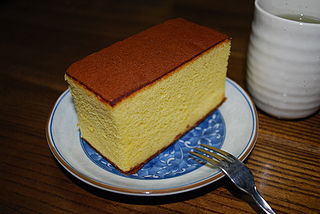 W
WCastella is a kind of wagashi originally developed in Japan based on the "Nanban confectionery". The batter is poured into large square or rectangular molds, baked in an oven and cut into long rectangular shapes. Since the recipe calls for mizuame, a type of sugar syrup, Castella has a moist texture.
 W
WChinsuko is a traditional sweet made in Okinawa since the times of the Ryukyu Kingdom, and often sold as a souvenir (Miyagegashi). It is a small biscuit made of mostly lard and flour, with a mild and sweet flavor similar to shortbread.
 W
WCoffee jelly is a jelly dessert flavored with coffee and sugar. Although once common in British and American cookbooks, it is now most common in Japan, where it can be found in most restaurants and convenience stores. Coffee jelly can be made using instant mix or from scratch. It is served in restaurants and cafés.
 W
WCrab ice cream is a flavour of ice cream with crab. Invented by the Japanese and known to them as Kani aisu, it is described as having a sweet taste. It is offered in some food establishments, particularly ice cream parlours, such as Heston Blumenthal's The Fat Duck restaurant, and the Venezuelan Coromoto, which offers the largest number of ice cream flavours in the world.
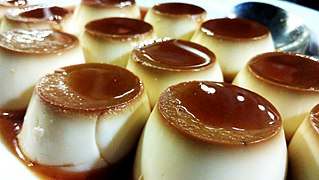 W
WCrème caramel, flan, caramel pudding or caramel custard is a custard dessert with a layer of clear caramel sauce.
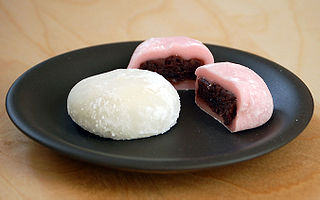 W
WDaifukumochi (大福餅), or daifuku (大福), is a wagashi, consisting of a small round mochi stuffed with a sweet filling, most commonly anko,. Daifuku is a popular wagashi in Japan and is often served with green tea.
 W
WDango is a Japanese dumpling made from rice flour mixed with uruchi rice flour and glutinous rice flour. It is different from the method of making mochi, which is made after steaming glutinous rice. Dango is usually finished round shaped, three to five dango are often served on a skewer. Generally, dango comes under the category of wagashi, and is often served with green tea. It is eaten year-round, but the different varieties are traditionally eaten in given seasons.
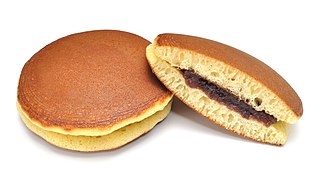 W
WDorayaki is a type of Japanese confection. It consists of two small pancake-like patties made from castella wrapped around a filling of sweet azuki bean paste.
 W
WFish-shaped pastry refers to the Japanese pastry Taiyaki, which is shaped to resemble a bream or Asian carp, and then is filled with red bean paste or other fillings like custard or chocolate. It is derived from the similar Japanese pastry called Imagawayaki. It is also popular in other East Asian countries such as: South Korea where it is known as bungeoppang.
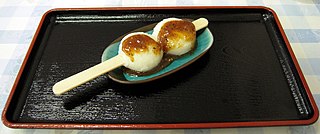 W
WGoheimochi is a type of mochi made in the Chubu region of central Japan, specifically in Nagano, Gifu, and Aichi prefectures. Unlike regular mochi it is coated with a type of sweet and sour sauce, usually composed of sugar, soy sauce, and mirin. The mochi is then skewered and grilled. Goheimochi is typically made in one of two shapes: Waraji is shaped like a traditional sandal and rounded mochi is served on a skewer. The mochi is usually only half-cooked so that some grains of rice remain, the rice is usually short-grain rice giving goheimochi a firmer texture compared to standard mochi.
 W
WGreen tea ice cream or matcha ice is a Japanese ice cream flavor. This flavor is popular in Japan and other parts of East Asia. Green tea ice cream is also sold in monaka form. It has been available in the United States since the late 1970s, primarily in Japanese restaurants and markets, but is currently moving into mainstream availability.
 W
WHakuto jelly (白桃ゼリー) is a seasonal Japanese dessert available in the summer. It is made using the juice of ripe hakuto peaches from Okayama and mineral-rich spring water. The texture is very smooth and soft, similar to the texture of the fruit itself. It has a light floral/peach aroma and taste. Hakuto jelly often comes in a container designed like the peach it was made from. Hakuto jelly can either be cut into cubes and served as such, or eaten with a spoon from the container. It is best served as a cold dish. Because it is a seasonal dessert, the taste of hakuto jelly differs slightly every year as the peaches do each season. Due to the quality of the peaches used to create it, hakuto jelly is very expensive.
 W
WHoney toast (Japanese:ハニートースト), also known as Shibuya toast, brick toast, and hanito is a Japanese dessert that originated from the district of Shibuya during the Japanese asset price bubble, often served at karaoke bars. It is also popular in other parts of the world, most prominently Taiwan and Singapore.
 W
WImagawayaki (今川焼き) is a Japanese dessert often found at Japanese festivals as well as outside Japan, in countries such as Taiwan and South Korea. It is made of batter in a special pan, and filled with sweet azuki bean paste, although it is becoming increasingly popular to use a wider variety of fillings such as vanilla custard, different fruit custards and preserves, curry, different meat and vegetable fillings, potato and mayonnaise. Imagawayaki are similar to dorayaki, but the latter are two separate pancakes sandwiched around the filling after cooking, and are often served cold.
 W
WKippan (桔餅), also chippan are an Okinawan confection. They are crafted individually by hand from lightly peeled kunibu or kunenbo and kaabuchī citrus from Yanbaru, reduced with sugar for several hours, then coated in liquid sugar; sometimes they are dusted with further toppings, such as matcha; the whole process can take up to four days. Kippan date from the time of the Ryūkyū Kingdom. Understood to have been originally introduced from Fuzhou some three hundred years ago, they were served to visiting dignitaries of the Imperial Chinese Missions. Available to the people at large from the Meiji period, today they continue to be made only by one sixth-generation purveyor in Naha. Kippan have been recognized by the Agency for Cultural Affairs as a constituent element of the Japan Heritage "story" Traditional Ryūkyūan Cuisine, Awamori, and Performing Arts of Okinawa that have continued unbroken since the time of the Ryūkyū Kingdom.
 W
WThere have been more than 300 limited-edition seasonal and regional flavors of Kit Kat chocolate bars produced in Japan since 2000, many exclusive to the country and not produced elsewhere. Nestlé, which operates the Kit Kat brand in Japan, reports that the brand overtook Meiji Chocolate as the top-selling confection in Japan from 2012 to 2014. The company's marketing campaign, which partnered with Japan Post to sell the bar in 20,000 post offices, won an award in 2010. The campaign encouraged associations of the product's name with the coincidental cognate Kitto Katsu (きっと勝つ), translated as "You will surely win", and could be mailed as a good luck charm for students ahead of university exams.
 W
WManjū is a traditional Japanese confection. Of the many varieties of manjū, most have an outside made from flour, rice powder, kudzu, and buckwheat, and a filling of anko, usually made from boiled adzuki beans and sugar. Manjū is sometimes made with other fillings such as chestnut jam. In Hawaii, one can find Okinawan manjū that are made with a filling of purple sweet potato, butter, milk, sugar, and salt, but the most common filling is bean paste, of which the several varieties include koshian, tsubuan, and tsubushian.
 W
WA melonpan is a type of sweet bun originating from and popular in Japan, as well as in Taiwan and China. They are made from an enriched dough covered in a thin layer of crisp cookie dough. Their appearance resembles a melon, such as a rock melon (cantaloupe). They are not traditionally melon flavored, but in recent times it has become popular for manufacturers to add melon flavoring to melon bread. Variations exist, including some with a few chocolate chips between the cookie layer and the enriched dough layer, and non-melon versions flavored with caramel, maple syrup, chocolate, or other flavors, sometimes with syrup, whipped or flavored cream, or custard as a filling. In the case of such variations, the name may drop the word "melon", instead replacing it with the name of the contents or may keep it despite the lack of melon flavor.
 W
WMitsumame (みつまめ) is a Japanese dessert. It is made of small cubes of agar jelly, a white translucent jelly made from red algae or seaweed. The agar is dissolved with water to make the jelly. It is served in a bowl with boiled red field peas, often gyūhi, Shiratama dango and a variety of fruits such as peach slices, mikan, pieces of pineapples, and cherries. The mitsumame usually comes with a small pot of sweet black syrup, or kuromitsu which one pours onto the jelly before eating. Mitsumame is usually eaten with a spoon and fork.
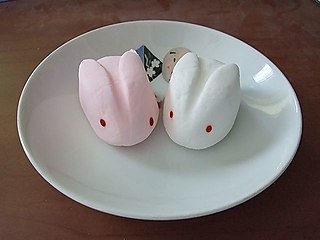 W
WMiyagegashi, also miyagekashi , refers to a sweet made with the purpose of selling it as a souvenir. As with most other Japanese souvenirs (omiyage), the typical miyagegashi is a regional specialty (meibutsu) and cannot be bought outside its specific geographic area. The making and selling of omiyagegashi is an important part of Japan's omiyage (souvenir) industry.
 W
WMochi is a Japanese rice cake made of mochigome, a short-grain japonica glutinous rice, and sometimes other ingredients such as water, sugar, and cornstarch. The rice is pounded into paste and molded into the desired shape. In Japan it is traditionally made in a ceremony called mochitsuki . While eaten year-round, mochi is a traditional food for the Japanese New Year, and is commonly sold and eaten during that time.
 W
WMochi ice cream is a confection made from Japanese mochi with an ice cream filling. It was invented by Japanese-American businesswoman and community activist Frances Hashimoto.
 W
WMomiji manjū is a type of manjū and Imagawayaki. The confection is a buckwheat and rice cake shaped like a Japanese maple leaf, and is a local specialty on the island of Itsukushima (Miyajima) in Hiroshima. It is typically filled with red bean paste.
 W
WRaindrop cake is a dessert made of water and agar that is supposed to resemble a raindrop. It first became popular in Japan in 2014, and later gained international attention.
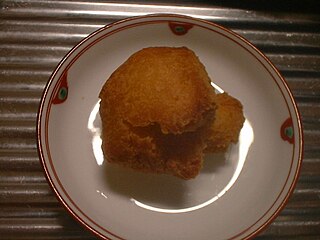 W
WSata andagi are sweet deep fried buns of dough similar to doughnuts, native to Southern China then spread to the Japanese prefecture of Okinawa. They are also popular in Hawaii, sometimes known there simply as andagi. Traditional Okinawan andagi is made by mixing flour, sugar and eggs. The ingredients are mixed into a ball and deep fried.
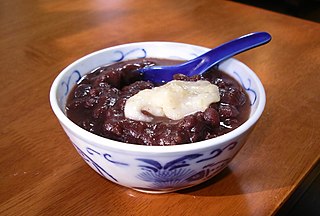 W
WShiruko (汁粉), or oshiruko (お汁粉) with the honorific o (お), is a traditional Japanese dessert. It is a sweet porridge of azuki beans boiled and crushed, served in a bowl with mochi. There are different styles of shiruko, such as shiruko with chestnuts, or with glutinous rice flour dumplings instead of mochi.
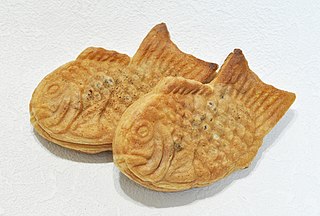 W
WTaiyaki is a Japanese fish-shaped cake, commonly sold as street food. It imitates the shape of tai , which it is named after. The most common filling is red bean paste that is made from sweetened azuki beans. Other common fillings may be custard, chocolate, cheese, or sweet potato. Some shops even sell taiyaki with okonomiyaki, gyoza filling, or a sausage inside. Smaller, differently shaped versions called kingyoyaki are also available and often sold in bags of five, ten, or more.
 W
WTokyo Banana is a Japanese banana-shaped sponge cake with cream filling. It is the official souvenir sweet of Tokyo and is manufactured and sold by Grapestone Co..
 W
WManjū is a traditional Japanese confection. Of the many varieties of manjū, most have an outside made from flour, rice powder, kudzu, and buckwheat, and a filling of anko, usually made from boiled adzuki beans and sugar. Manjū is sometimes made with other fillings such as chestnut jam. In Hawaii, one can find Okinawan manjū that are made with a filling of purple sweet potato, butter, milk, sugar, and salt, but the most common filling is bean paste, of which the several varieties include koshian, tsubuan, and tsubushian.
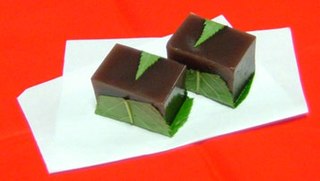 W
WYōkan is a wagashi made of red bean paste, agar, and sugar. It is usually sold in a block form, and eaten in slices. There are two main types: neri yōkan and mizu yōkan. "Mizu" means "water", and indicates that it is made with more water than usual. Mizu yōkan is often chilled and eaten in the summer.